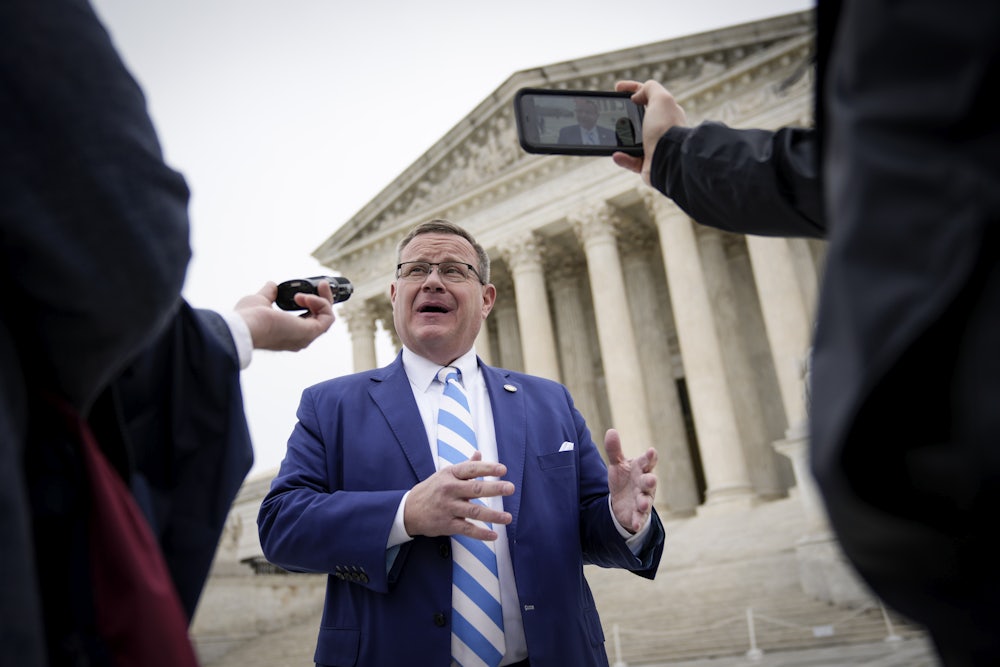Republicans in North Carolina are poised to wipe out the prospect of competitive legislative elections in their state for the rest of the decade. A state Senate committee voted on Monday to advance a new set of maps for congressional and state legislative districts. Since North Carolina’s governor can’t veto redistricting plans, all that’s left is for final votes in the state House of Representatives and state Senate.
In theory, North Carolina is a purple state where no political party has an inherent advantage. This is especially true in statewide races. Donald Trump defeated Joe Biden by only a 1.34 percent margin in 2020. During that same election, North Carolinians also elected multiple Democrats to the state’s executive branch, including Governor Roy Cooper and Attorney General Josh Stein. Recent U.S. Senate contests have been closely fought.
The same can’t be said for legislative races in North Carolina. Thanks to more than a decade of extreme partisan gerrymandering, Republicans have an ironclad grip on the state legislature. That dominance has allowed them to effectively decide most of the state’s legislative races, both for the state Assembly and for Congress, before voters even cast a ballot. But with this latest move, the Tar Heel State is poised to slip even further away from what could fairly be called “representative government.”
If enacted, the new congressional map would essentially hand three additional House seats to Republican candidates in 2024. The state’s current map, which was drawn by a state court in 2022 after post-census legal battles, resulted in seven Democrats and seven Republicans elected to Congress. Under the new map, Republicans would instead hold a virtually unbeatable edge in 10 of the state’s 14 districts. Democrats would be all but guaranteed to win two of the remaining districts, while the final one would be slightly favorable toward Republicans.
That would radically alter who gets represented by whom. For example, the new map would crack open the city of Charlotte, an urban Democratic stronghold, and pack most of its residents into one super-Democratic district. The rest would be divided among the three surrounding rural districts. A similar crack-and-pack scheme also targets Raleigh, the state’s largest city, to make the surrounding suburbs less pivotal by absorbing them into larger rural ones.
Representative Jeff Jackson, a Democrat who represents the state’s 14th district, which covers southern Charlotte, said last week that he is all but guaranteed to lose next year thanks to the new maps. “Two draft maps are out, and both of them draw me out of my district and put [me] in one that is totally unwinnable,” he explained in a video post on Twitter. “If either of these maps become final, it means I’m toast in Congress.”
North Carolina Republicans haven’t been subtle about their goals since embarking upon this path after the 2010 midterm elections. “I propose that we draw the maps to give a partisan advantage to 10 Republicans and three Democrats, because I do not believe it’s possible to draw a map with 11 Republicans and two Democrats,” a state lawmaker famously quipped during an earlier redistricting battle in 2016. (North Carolina gained a fourteenth seat after the 2020 census.)
Like every other state in the Union, North Carolina redrew its legislative maps after the 2020 census. Republican lawmakers, true to form, passed new district boundaries that would continue to entrench them in power. Their path had been cleared by the Supreme Court’s 2019 decision in Rucho v. Common Cause, which closed the door to Fourteenth Amendment challenges to partisan gerrymandering in federal courts. That ruling effectively ended the legal battles that had dogged state lawmakers for most of the 2010s.
This time, however, the maps ran into difficulty from another angle. The North Carolina Supreme Court, which is technically nonpartisan but had a 4–3 liberal majority at the time, struck down the maps in 2022 by concluding that the gerrymanders had violated the state Constitution. The Supreme Court typically has no jurisdiction over state supreme court interpretations of state constitutions, leaving North Carolina Republicans with no clear recourse.
Instead, they tried a Hail Mary option by asking the U.S. Supreme Court to overturn the North Carolina state Supreme Court’s decision under the independent state legislature theory. Under the most common version of that theory, Article I of the federal Constitution gives state legislatures the exclusive power to determine a state’s election and voting laws. Proponents of the theory believe that other portions of the state government, like state courts, can’t countermand the legislature’s decisions as they could for ordinary laws.
In a 6–3 ruling, however, the justices rejected that theory outright. “We are asked to decide whether the Elections Clause carves out an exception to this basic principle,” Chief Justice John Roberts wrote for the court. “We hold that it does not. The Elections Clause does not insulate state legislatures from the ordinary exercise of state judicial review.” That allowed the court-drawn maps to stand for the 2022 midterms.
The battle did not end there, however. In those midterm elections, voters elected two new conservative judges to North Carolina’s state Supreme Court. They quickly joined with their colleagues on the new 5–2 majority to overturn the court’s 2022 ruling, holding that partisan-gerrymandering claims now weren’t justiciable under the state Constitution either. That closed the door to the last legal recourse left to voting rights groups to challenge partisan entrenchment. State lawmakers then set out to redraw the court-imposed maps in time for next year’s election.
Things won’t change as much at the state level, though not for lack of effort by North Carolina Republicans. “The North Carolina Constitution puts a bit of a brake on gerrymandering of state House and Senate maps through the ‘whole county rule,’ which mandates that counties must be kept intact, when possible,” WFAE reporter Steve Harrison wrote in an analysis earlier this week. “That limits the creativity of mapmakers and prevents a near-total wipeout of Democrats. Under the proposed new House map, if Democrats performed as well as Biden did in 2020, they would win 49 seats to the GOP’s 71.”
That would place the projected results roughly in line with where they currently stand: The North Carolina House currently consists of 72 Republicans and 48 Democrats. Of course, even that only speaks to the strength of the existing gerrymander. In the 2020 North Carolina House elections, GOP candidates won 49.99 percent of the overall vote and Democrats won 49.06 percent of it. Republicans nonetheless won 18 more seats in the chamber. Such is the power of partisan gerrymandering.
Not all options for recourse are dead. The Supreme Court’s ruling this year in an Alabama redistricting case shows that racial-gerrymandering lawsuits are still viable, though it is too soon to tell whether one could be pursued against the latest maps. Congress could also theoretically require all states to adopt proportional representation for House races and end gerrymandering forever. Either way, by forcing voters to fight tooth and nail just to have a shot at fair representation in their own state legislatures, North Carolina Republicans have already won.










